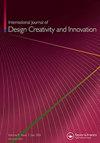羞辱中的潜在价值:一种在创造性思维中增强同理心的设计思维工具
IF 2.5
Q4 ENGINEERING, MANUFACTURING
International Journal of Design Creativity and Innovation
Pub Date : 2021-09-06
DOI:10.1080/21650349.2021.1976677
引用次数: 0
摘要
摘要设计思维强调,设计解决方案除了要有创造性之外,还应具有同理心。然而,研究表明,这些目标之间可能存在紧张关系,专注于同理心是以创造力为代价的,有时会引起固定。我们通过对新手设计师的准实验设计来研究这一现象,对比了两种结构化思维技术,在这两种技术中,参与者(N=47)在提出有益的想法之前产生了坏想法。具体来说,他们使用错误理论协议(WTP)产生了有害和羞辱性的想法,并在一个变体中产生了愚蠢和不可能的想法(SIP)。我们使用定性分析来描述他们的坏想法和有益想法。在两个现实的设计挑战中,我们发现学生最初糟糕的设计作品是由他们使用的技术决定的,而那些产生羞辱性想法的人更有可能在之后产生富有同情心的有益想法。在解决方案思想的广度上没有发现系统性的差异,这表明这种技术不会以创造力为代价。作为一种快速且易于使用的技术,在产生有益想法之前产生羞辱性想法有望成为达成既有同理心又有创造性的设计解决方案的一种手段。本文章由计算机程序翻译,如有差异,请以英文原文为准。
Latent value in humiliation: A design thinking tool to enhance empathy in creative ideation
ABSTRACT Design thinking emphasizes that in addition to being creative, design solutions should be empathetic. Yet, research suggests there may be a tension between these goals, where focusing on empathy comes at a cost to creativity, sometimes by inducing fixation. We investigated this phenomenon through a quasi-experimental design with novice designers, contrasting two structured ideation techniques in which participants (N = 47) generated bad ideas prior to proposing beneficial ideas. Specifically, they used the wrong theory protocol (WTP) to generate harmful and humiliating ideas, and a variant in which they instead generated silly and impossible ideas (SIP). We used qualitative analysis to characterize their bad and beneficial ideas. Across two realistic design challenges, we found students’ initial bad design work was shaped by the technique they used, and that those who generated humiliating ideas were more likely to generate empathetic beneficial ideas afterward. No systematic differences were found in the breadth of solution ideas, suggesting this technique does not come at a cost to creativity. As a quick and easy-to-use technique, generating humiliating ideas prior to generating beneficial ideas holds promise as a means to reach design solutions that are both empathetic and creative.
求助全文
通过发布文献求助,成功后即可免费获取论文全文。
去求助
来源期刊

International Journal of Design Creativity and Innovation
ENGINEERING, MANUFACTURING-
CiteScore
3.80
自引率
27.80%
发文量
15
期刊介绍:
The International Journal of Design Creativity and Innovation is an international publication that provides a forum for discussing the nature and potential of creativity and innovation in design from both theoretical and practical perspectives. Design creativity and innovation is truly an interdisciplinary academic research field that will interest and stimulate researchers of engineering design, industrial design, architecture, art, and similar areas. The journal aims to not only promote existing research disciplines but also pioneer a new one that lies in the intermediate area between the domains of systems engineering, information technology, computer science, social science, artificial intelligence, cognitive science, psychology, philosophy, linguistics, and related fields. The journal covers, but is not restricted to, the following topics: ·Theories on Design Creativity and Innovation ·Cognition of Design Creativity ·Innovative Process ·Inventive Process ·Analogical Reasoning for Design Creativity and Innovation ·Design Synthesis ·Method and Tools for Design Creativity and Innovation ·Representation of Design Creativity and Innovation ·Education for Design Creativity and Innovation ·Concept Generation and Inspiration.
 求助内容:
求助内容: 应助结果提醒方式:
应助结果提醒方式:


